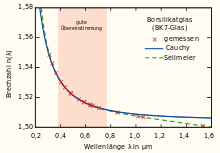Sellmeier equation
The Sellmeier equation in optics is an empirically determined, functional description of the dependence of the refractive index of a light-permeable medium on the wavelength of light. The equation was named after Wolfgang von Sellmeier , who published it in 1871 based on the Cauchy equation and Kramers-Kronig relation . It is mainly used in technical optics to describe the dispersion of optical glass and other optical materials.
Mathematical description
| coefficient | value |
|---|---|
| B 1 | 1.03961212 |
| B 2 | 0.231792344 |
| B 3 | 1.01046945 |
| C 1 | 6.00069867 10 −3 μm 2 |
| C 2 | 2.00179144 10 −2 μm 2 |
| C 3 | 103.560653 μm 2 |

The Sellmeier equation can be understood as an extension of the Cauchy equation , it reads:
with B 1,2,3 and C 1,2,3 as experimentally determined Sellmeier coefficients . The B 1,2,3 are dimensionless and the C 1,2,3 are usually given in μm² .
The accuracy in the visible range is usually better than .
The right term of the equation can also be expanded to include additional summands for greater accuracy:
If one sets , then they can be explained as resonance wavelengths of absorption lines or bands.
See also
Individual evidence
- ↑ Dirk Poelman, Philippe Frederic Smet: Methods for the determination of the optical constants of thin films from single transmission measurements: a critical review . In: Journal of Physics D: Applied Physics . tape 36 , no. 15 , 2003, p. 1850–1857 , doi : 10.1088 / 0022-3727 / 36/15/316 .
- ↑ Wolfgang von Sellmeier: To explain the abnormal color sequence in the spectrum of some substances . In: Annals of Physics and Chemistry . tape 143 , 1871, pp. 272–282 , doi : 10.1002 / andp.18712190612 ( digitized on Gallica ).






